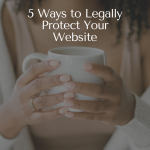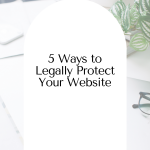
5 Ways to Legally Protect Your Website
Table of Contents
ToggleSharing is caring!
Reading Time: 3 minutes


Your website is an essential part of your business, and as the owner, you should know how to protect it legally. You don't want a lawsuit ruining all of your hard work! Here are tips on how!
Just like any newbie entrepreneur, you're probably raring to start monetizing your website as soon as possible. Unfortunately, newbies tend to focus too much on finding a client and making profits than other pressing concerns such as providing legal protection to your website.
Your website plays a central role in your business. It should be protected at all costs. Otherwise, you might end up losing all your hard work over a lawsuit. Protect your business by protecting your website. Here are ways how:
5 Ways to Legally Protect Your Website
Protect Your Intellectual Property
A copyright and trademark symbol protects your intellectual property. The symbol denotes that all the content that appears on your website is yours, and these cannot be used without your permission.
The copyright ( ©) and trademark (™) symbols are often found at the bottom of websites. If you’ve registered a trademark, use the ® sign.
To protect your website, add the copyright disclosure on the bottom of your website. Use the copyright symbol ©, including the current year and your business name. Ex: © 2022 [Your Business Name]. This is the easiest way to protect your website and its content legally. In the event of any dispute, lawyers can work with you to ensure that your intellectual property rights are protected.
Website Terms and Conditions
You should dedicate an entire webpage to your website’s terms and conditions. The Terms and Conditions outline all the agreed conditions and obligations on your website's acceptable uses between yourself and your website viewers. This step helps protect your website from being misused by other people.
Be sure that the terms and conditions are stated clearly. It should be written in a way that clarifies all the acceptable uses of your website and the actions you’ll implement if your website is being misused by a viewer, such as banning the said user.
You can search for a free Terms and Conditions template online or pay for a template at your local law firm. If you have a lawyer, you can also ask them to draft the website terms and conditions for you.
A (GDPR- Compliant) Privacy Policy
Along with the website terms and conditions, you should also define your privacy policy. Your privacy policy should outline when and how you’re collecting and storing user data. The data includes:
- Names
- Email address
- Browsing history
- Any data collecting analytics used by Google, Facebook, and other apps you use
If your business has VIP memberships, a weekly/monthly newsletter, or any offers that require data collection of any kind, you have to let people know about it. You have to outline what information you’re collecting to protect user privacy.
Take your privacy policy a step higher by creating a GDPR-compliant one. Even if your business does not belong in the European Union, EU residents must know what to expect when browsing your website. It is hard to filter website traffic, and you don’t want to pay fines for unknowingly violating the GDPR. Your Privacy Policy should be compliant with other Consumer Privacy state laws, such as the California Consumer Privacy Act, to be on the safe side.
Use Paid or Royalty-Free Content
These days, it’s no longer okay to google an image online and use it for your website content. Most images are copyright protected, and search engines take great lengths to warn users about using these images for promotions.
To avoid potential problems, only use paid or royalty-free content. For paid content, you can hire a graphic artist to create visual content and other branding materials for your website – logo, images, videos, etc. If you’re using royalty-free content, websites such as Unsplash, Pixa Bay, or Pexels can be used without attribution requirements.
If you are using your customers’ images for testimonials or team members for your About Us page, for example, be sure to let your team members know about it and have them sign a release form before using their images on your website. Keep these docs for future reference.
A Secure Website
You need to protect your website and your customers’ data from threats, so you should invest in Secure Sockets Layer (SSL) or Transport Layer Security (TLS). This communication protocol encrypts website and user information against hackers, phishing sites, malicious programs, etc. All trusted websites have a Hypertext Transfer Protocol Secure or HTTPS. That’s because Google and other search engines prioritize websites with HTTPS.
If you’re using WordPress, keep your plugins updated regularly to boost your website security. Back up your website regularly. Enable the 2-factor authentication for good measure and use strong passwords and user names.
Don’t let your hard work go to waste; keep your website and its content protected. Be sure that you’re also protecting user data to avoid legal tangles. With these tips, your website, your business, and user rights are legally protected!
Most Popular Posts:
Sharing is caring!
PLEASE COMMENT BELOW